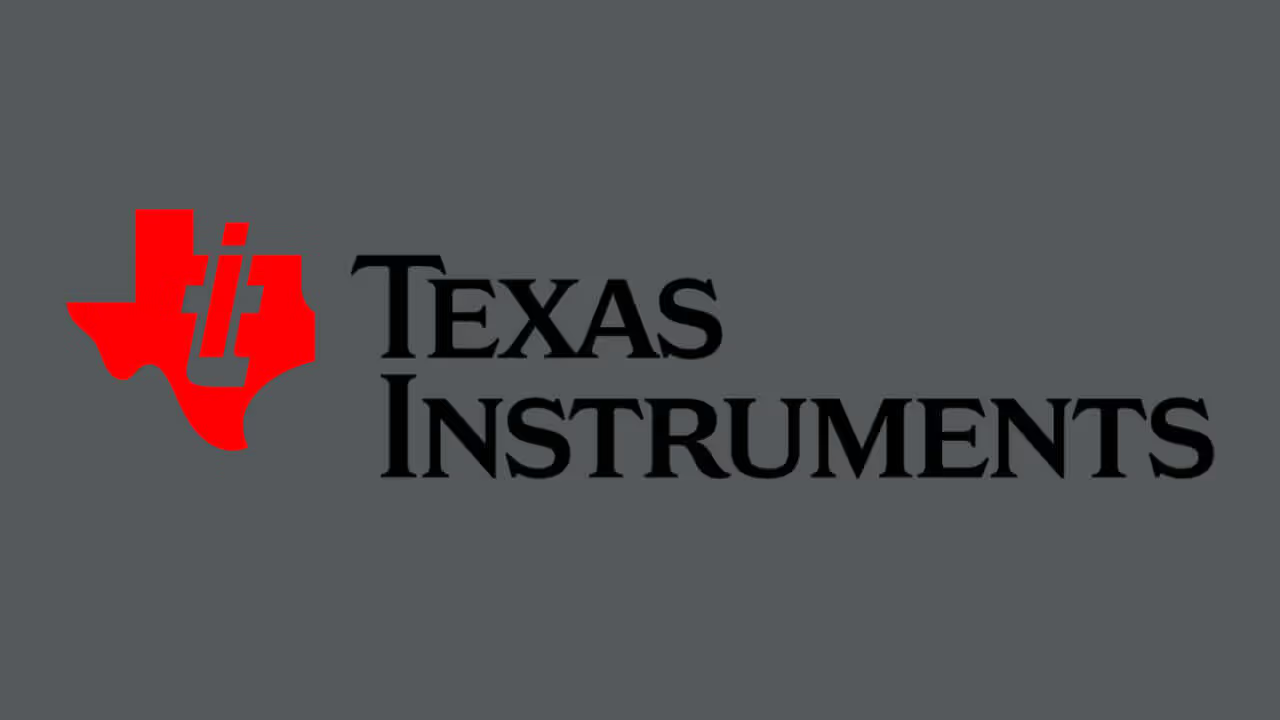Texas Instruments is the leading supplier of semiconductors, specializing in the production and research of analog products and embedded chips.
Texas Instruments makes products that help electronic designers and manufacturers develop new applications, especially digital ones, in the industrial, automotive, and communications industries.
2021 Statistics Highlighting Texas Instrument’s Success
- Sales revenue of $18.3 billion
- Net Income of $7.8 billion
- Operating profit of $9.0 billion
- More than 31,000 employees
- 15 manufacturing sites worldwide
- The product portfolio contains over 80,000 products for over 100,000 customers.
- Spent over $1.6 billion in research and development
Let's dive deep into the history of Texas Instruments to understand how it became the world's largest supplier of semiconductors.
The Birth of Texas Instruments
Texas Instruments started as a small oil and gas exploration service called Geophysical Service Inc. (GSI) in 1938.
The company used signal processing technology to devise a clever technique to search for oil underground.
The revolutionary spirit of those early days continues to define Texas Instruments to this day and has been the force behind many of the firm's ground-breaking innovations that have shaped the lives of people the world over.
Let's take a look at how it all began.
An Electronic Firm is Born
GSI mainly provided seismographic data for the petroleum industry. In 1941, the firm was acquired by Eugene McDermott, Cecil Green, Erik Jonsson, and H.B. Peacock.
By this time, WWII was well underway, and the company had to step up to meet the country's needs during wartime.
GSI soon received a contract from the U.S. Navy to create a device that aircraft could use to detect submarines.
Oil exploration is what GSI did best, so it went back to the drawing board and reinvented oil-detecting technologies to create a submarine detection device.
The new devices could be loaded onto low-flying aircraft and detect the magnetic waves generated by submarines below the ocean’s surface.
Necessity is the mother of invention, and by the time the war ended, the company was no longer just an oil exploration service. It was now a full-fledged electronics firm.
Lieutenant Patrick Haggerty, who the Navy tasked to manage GSI's contract, officially joined the new electronics firm as the head of the manufacturing division.
Afterward, the only way to stay ahead of the competition was to adapt wartime technology for peaceful purposes such as producing consumer goods. GSI had shown that it could reinvent products as the need arose.
So, the first thing that GSI did was to reinvent itself as Texas Instruments in 1951 to reflect its service diversification far beyond the oil and gas exploration sector.
The following year, Texas Instruments purchased a license to start producing germanium transistors. Within two years, the company had initiated mass production.
Still, the research team at Texas Instruments was busy experimenting with a new kind of transistor that would be resistant to higher temperatures.
A critical breakthrough came in 1954 when lead researcher Gordon Teal produced the first silicon transistor.
Haggerty was well aware of the high demand for transistors and soon established the Texas Instruments semiconductor division. The new division set to work on developing the world’s first transistor radio.
It was the first time that transistors had been used to produce radios and the new technique had two main benefits.
Firstly, it reduced the radio's power consumption to make it work longer. Secondly, the use of transistors helped reduce the size of the radio so that people could easily carry it in a purse or pocket.
Texas Instruments named the new device the 'Regency Radio' and strategically released it around Christmas time when people tuned in to listen to special Christmas broadcasts and shows.
The move paid off, and the new pocket-sized radio was instantly successful. People loved that they could fit their radio into a pocket and hear their favorite shows wherever they went, which was a novelty back then.
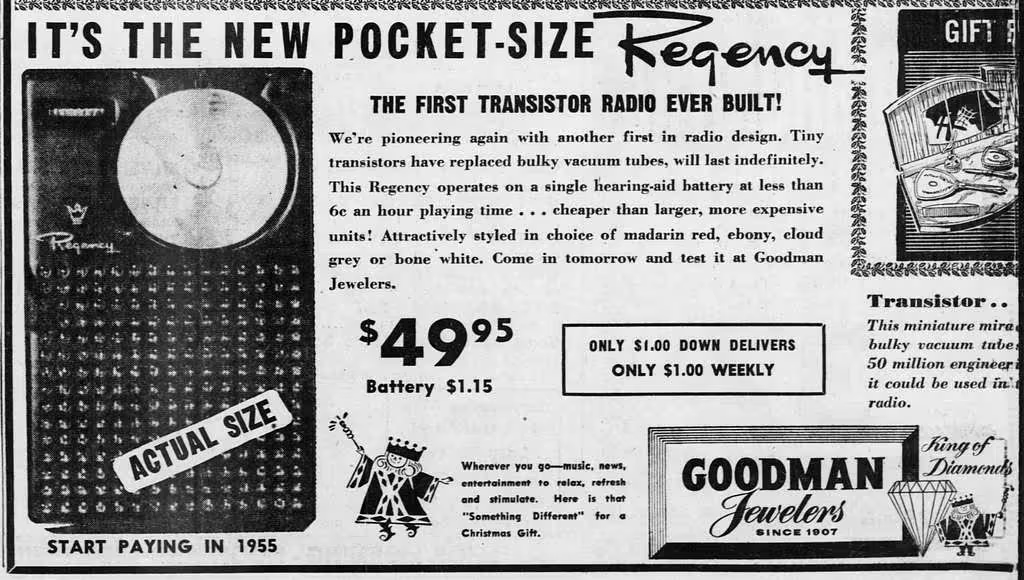
This was reflected in the sales figures. While Texas Instruments had only managed to bring in sales worth $6.4 million in 1949, it was now clocking in sales at $92 million ($1.1 billion today after adjusting for inflation), cementing its position as the leading electronics manufacturer in the U.S.
TI Invents the First Integrated Circuit
In 1958, when Haggerty took over as President, Jack Kilby, a researcher at Texas Instruments co-invented the first integrated circuit.
Kilby found a way to create an entire circuit in a single step. The new circuit consisted of all the necessary components such as transistors, capacitors, resistors, and wires soldered onto a single circuit made out of silicon.
Haggerty quickly realized that the integrated circuit was the next big thing, but his firm did not have the required funds to start mass-producing the new product.
It was the height of the Cold War, and the U.S. was engaged in an arms race with the Soviet Union.
The U.S. Air Force needed a company to supply integrated circuits to produce the latest missile to close the 'missile gap' with the USSR.
TI was already a prominent supplier of semiconductors to the U.S. military and was well known for its services during WWII.
So, when they launched a new missile program, the U.S. Air Force awarded the contract to Texas Instruments for further research and development of integrated circuits which scientists could incorporate into computers for ballistic missile guidance systems.
By 1962, the U.S. had successfully deployed the first intercontinental ballistic missile, which was only possible with the help of the integrated circuits delivered by Texas Instruments. Dubbed the Minuteman missile, it has remained a mainstay of the American nuclear arsenal to the present day.
But Haggerty and his team of researchers knew that the integrated circuits had a massive range of applications and could also be used to produce consumer goods. In 1964, Texas Instruments collaborated with Zenith Radio Corporation to create a hearing aid.
The new device was among the first to be built with an integrated circuit. An integrated circuit had all the circuit components on a single silicon crystal which was more compact and helped reduce the size of the new hearing aids.
Previously, hearing aids had been bulky devices with a separate battery and microphone, but the new hearing aids had an in-built microphone and internal receiver.
Texas Instruments EdTech Innovation Strategy: The First Pocket-size Calculator
The hearing aids were just the start, and Haggerty soon commissioned Jack Kilby to start working on producing an affordable electronic calculator using integrated circuit technology.
By 1967, Kilby successfully designed a prototype for the new hand-held calculators that weighed just under 45 ounces.
It would take another five years of meticulous testing and refinement for the final product to take shape. Nevertheless, the team at Texas Instruments persevered, and in 1972, their efforts finally bore fruit with the creation of the TI Datamath pocket calculator.
Kilby and the team had worked hard to upgrade the integrated circuit technology to produce the new calculators using a single integrated circuit, which drastically reduced the manufacturing cost.
It helped Texas Instruments sell the new calculators at an affordable price so that students all over the U.S. could purchase them regardless of their socioeconomic background.
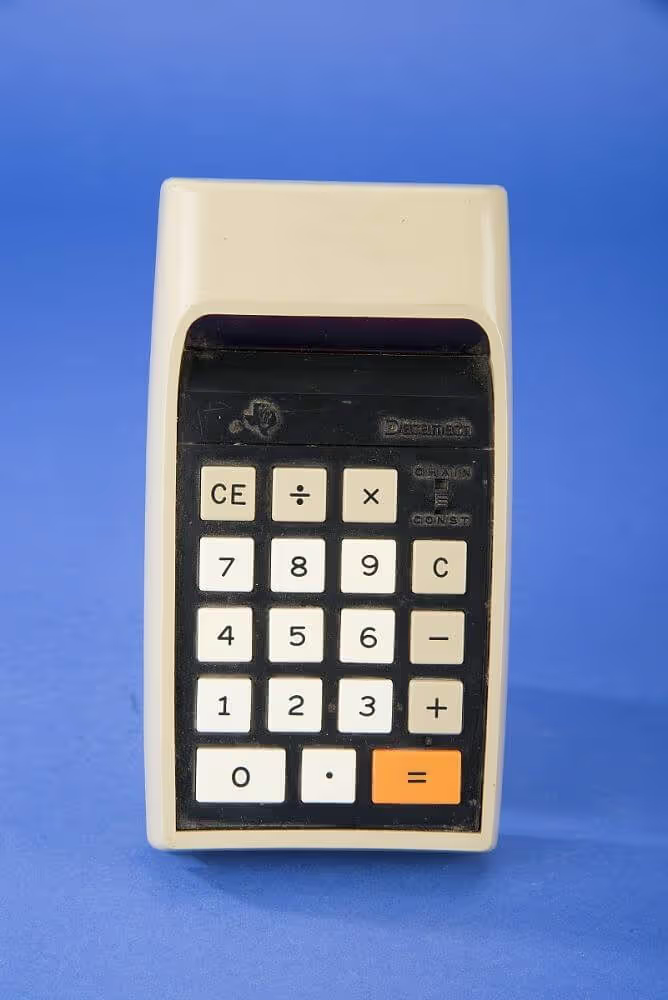
The company sold close to 3 million calculators within a year of its release, and sales grew exponentially from that point onwards, with 17 million calculators sold in 1973.
By 1975, calculator sales had crossed the 45 million ($241.8 million after adjusting for inflation) mark.
The new portable calculators were super handy and soon replaced the older desktop calculators and the analog slide rule calculators.
The TI Datamath had an eight-digit LED display and eighteen keys, including ten-digit keys, a decimal point key, four arithmetic function keys, a clear entry key, and a clear key.
The calculator also had an in-built battery that provided power for 4-6 hours and could be fully recharged in ten hours.
The Datamath calculator was Texas Instruments' first foray into educational technologies.
Two years later, Texas Instruments introduced the first scientific calculator, an upgraded version of the Datamath but with trigonometric and hyperbolic functions.
Over the years, the company has produced a range of other educational products, each more advanced than the last, to meet the needs of students in a rapidly digitizing educational environment.
Key Takeaway 1: Foster a Culture of Innovation by Recruiting the Best Talent
Since its inception, Texas Instruments has worked hard on recruiting the best talent.
The strategy helped Texas Instruments create a workplace that encouraged a culture of innovation and pushed its employees to test the boundaries of engineering and technology.
As a result, lead researchers at the company were able to develop groundbreaking inventions like the integrated circuit- a chip that changed the world. The invention was highly versatile, and scientists fitted it into specialized computers in missile systems and spacecraft.
Texas Instruments's top leadership also worked in tandem with the researchers to create products that would have mass appeal, such as portable radios and digital calculators, none of which would have been possible without a healthy focus on innovation.
Innovation Keeps Texas Instruments At the Forefront
From its earliest days, Texas Instruments' focus has always been on research and development.
This culture of innovation would serve the company well in the years to come, with many ground-breaking inventions along the way.
Texas Instruments Goes to the Moon
In 1967, Texas Instruments had successfully launched the first solid-state radar unit, yet another application of the revolutionary integrated circuit technology but for space exploration.
Using integrated circuits helped Texas Instruments reduce manufacturing costs and also helped the company build a radar that was smaller and more reliable.
The new radar units could be used in ground-based and airborne radar and communication systems.
In 1969, the Apollo 11 mission to the moon was possible thanks to Texas Instruments semiconductors and radar units.
The First Microcomputer Enhances Brand Appeal
In 1970, Texas Instruments invented the first single-chip microprocessor, also known as the first microcomputer.
The biggest advantage of this tiny microprocessor was that it could be used to make a host of computer-controlled appliances such as digital calculators and watches.
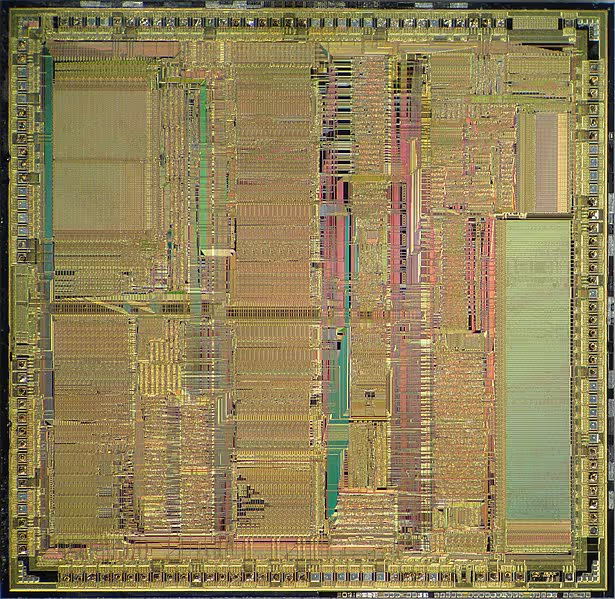
Texas Instruments had already seen much success with the release of its Datamath Calculator, and with the introduction of the microprocessor, the company was ready to produce more digital appliances.
In 1976, the company released its first digital watch for just $20, which threw the rest of its competitors for a loop and helped Texas Instruments gain a significant chunk of the electronic watch market.
Defence contracts remained a strong source of revenue even as Texas Instruments successfully marketed reliable and inexpensive digital products for the consumer market.
In the 70s, the demand for semiconductors such as microprocessors and integrated circuits soared worldwide and in the domestic market.
Defense electronics was an exceptionally lucrative market with a high demand for semiconductors, and Texas Instruments was able to capitalize on that to achieve semiconductor sales worth $1 billion by 1973 ($6.5 billion today after adjusting for inflation).
But Texas Instruments was just getting started and, in 1974, started producing the Dynamic Random Access Memory (DRAM) chips.
These chips were an early precursor to the RAM chips now commonly used in all computers.
The production of the DRAM chips caused another boom in demand for semiconductors, and the company was able to clock in sales worth $2 billion in 1977 and $3 billion in 1979 ($11.9 billion today after adjusting for inflation).
Texas Instruments EdTech Marketing Strategy for Young Learners
The Speak and Spell was an electronic hand-held child computer produced by Texas Instruments.
A team of engineers at Texas Instruments. began developing the child computer in 1976 as part of Texas Instruments.'s research into speech synthesis.
The final version included Texas Instruments.'s solid-state speech technology that stored speech in solid-state format.
The body was made using lightweight plastic painted in bright colors like orange and yellow to appeal to small children and make learning more fun.

The new computer also had space for more cartridges or freely exchangeable ROM libraries.
The extra cartridges were sold separately and could be inserted through the battery receptacle to load more word games or word libraries into the computer for additional learning.
It was the first time an educational toy used speech stored in solid-state format instead of the usual tape recorders.
The Speak and Spell was part of an educational toy series by Texas Instruments.
The company soon released the Speak and Read and the Speak and Math. Texas Instruments sold the products in the United States, United Kingdom, and Japan and marketed to children aged seven and above.
The team at Texas Instruments had designed this computer to help children learn to correctly spell over 200 commonly misspelled words.
Even the most basic version had three games called Mystery Word, Secret Code, and Letter. The extra cartridges held separate word lists specific to the toy's regional variations.
For instance, cartridges for the British toys contained slightly different word lists with words more commonly used in British English, while the American version had words more commonly used in the U.S. The word lists were also made using recommendations made by educators in each country.
The Speak and Spell computers were a resounding success, and children everywhere loved the new toy. It was so popular it was even featured in the 1982 classic children's movie E.T. the Extra-Terrestrial.
Soon afterward, the company released a special game in honor of the movie called the E.T. Fantasy Module. The player had to correctly spell ten words after hearing them spoken by the computer to win. The game asked children to spell words like universe, creature, and geranium.
The Speak and Spell initiative was part of Texas Instruments's long-standing commitment to producing the finest educational technology for students of all ages.
The company's calculator line was also going strong, and Texas Instruments released the first solar-powered calculator in the early 1980s.
The initial version had a panel of ten small solar panels under the display bar. The solar panels removed the need for traditional batteries and extended the life of Texas Instruments calculators indefinitely so that they could be used for years.
Key Takeaway 2: Invent Products with Multiple Applications
Texas Instruments has a demonstrable history of inventing products that are broad-based and can be incorporated into multiple systems to create new devices that can be used in diverse applications from missile systems and space exploration to educational tech and home appliances.
Texas Instruments's silicon transistors, integrated circuits, solid-state radars, and microprocessors are just a few examples of Texas Instruments. products that revolutionized the electronics industry.
These are not single-use products with few applications but products that can be incorporated to make any electronic device in the world.
Texas Instruments Acquisition Strategy In The Late 20th Century
The 90s and early 2000s were a turbulent time in Texas Instruments's history marked by a significant restructuring of the company's organization. Yet, the drive for innovation remained strong.
Texas Instruments produced a series of new products with various applications in multiple industries such as food safety, automobiles, and the cellphone industry.
The Birth of Digital Signal Processors
In 1982, Texas Instruments developed the first single-chip Digital Signal Processor (DSP), which could convert analog signals into digital form in real-time.
In 1994, Texas Instruments released the first multimedia video processor, which was the first processor made using multiple DSP chips. DSP chips were also needed to produce T.V. sets, internet modems, and cell phones.
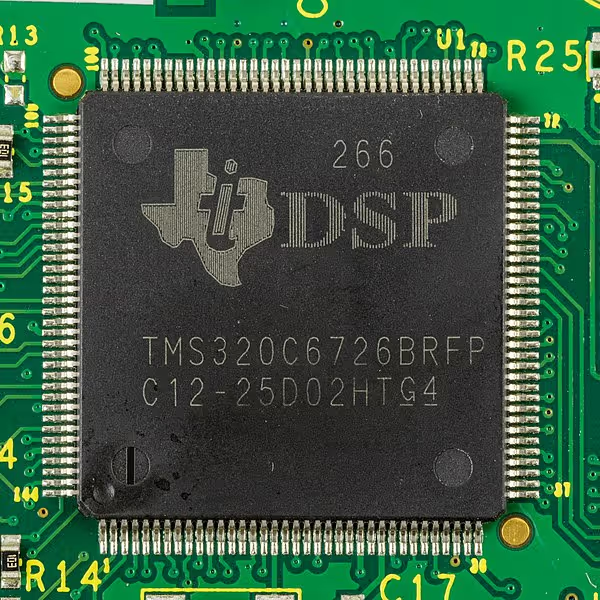
So, Texas Instruments was aware that the DSP chip market was going to grow significantly in the next five years, so it invested heavily in producing more advanced DSP chips.
In 1997, the company succeeded in producing a specialized DSP chip that could be used to detect biochemical signals.
There was high demand for the new DSP chip from makers of portable devices used to detect pathogenic bacteria and other pathogens in food and water. For instance, the DSP chips were needed in analog-to-digital converters in sensors in greenhouses.
The sensors would pick up biochemical analog signals such as humidity level, and the DSP chips would convert the analog signals into digital binary data in real-time.
The digital data would then feed into a computer that automatically activates the output system depending on the input data.
For example, the computer would activate the sprinklers if the humidity level was too low. In this way, DSP chips enabled the production of devices that could be used to remotely monitor conditions without the need for human intervention.
Texas Instruments.'s investment in the R&D of DSP chips paid off, and the company soon controlled around 45% of the market share in the DSP market.
By 1997, total revenue from the sale of DSP chips exceeded $1.4 billion ($2.5 billion today after adjusting for inflation).
The company supplied chips to meet multiple industrial needs, such as the production of automobile brake systems, stereophonic sound systems, and computer modems.
The 1990s - A Decade of Strategic Acquisitions
In 1996, a veteran Texas Instruments employee Tom Engibous took over the reins as President and CEO.
Engibous knew that things needed to change if Texas Instruments was to remain ahead in the electronics industry, so the first thing he did was to develop an aggressive acquisition and divestiture plan.
The company wanted to streamline its operations to better focus on the emerging DSP market. Hence, the company acquired Spectron Microsystems, Adaptec Inc., Oasix Corp, and Arisix Corp, which were more aligned with its DSP focus. The company also acquired GO DSP and Amati Corporations.
Texas Instruments also sold several of its other businesses, including Defense Systems & Electronics, Mobile Computing, Inspection Equipment, the Chemical Operations department, the Telecommunications Systems division, and the Power Semiconductor unit.
In 1998, it sold its memory chip division to Micron Technologies Inc. for $880 million ($1.6 billion today after adjusting for inflation).
The sale of these low-margin businesses helped free up funds for more strategic acquisitions.
In 1999, Texas Instruments acquired Butterfly VLSI Ltd. for approximately $50 million ($86.8 million today after adjusting for inflation) and Telogy Networks for $457 million ($793 million today after adjusting for inflation).
These new acquisitions helped the company develop more advanced DSP chips, such as a chip that could provide better Internet access. It also helped the company increase its market share in the DSP market to 48%, an increase of 3% from 1996 to 1999.
By 2000, Engibous’s efforts had paid off, and the company was in a far better financial position, with revenues hitting the $11.8 billion mark ($19.8 billion today) and a profit of $2.7 billion ($4.5 billion today after adjusting for inflation).
Texas Instruments also retained its traditionally dominant position in the semiconductors industry, and Texas Instruments released close to 200 new analog products in 1999.
Texas Instruments Successful Expansion Strategy for Educational Technology
The 90s was also when Texas Instruments churned out one amazing calculator after another and expanded the number of products it offered as part of its educational technology series.
In 1990, the company released the first-ever graphing calculator, the legendary TI-81, which was ideal for algebra and pre-calculus classes.
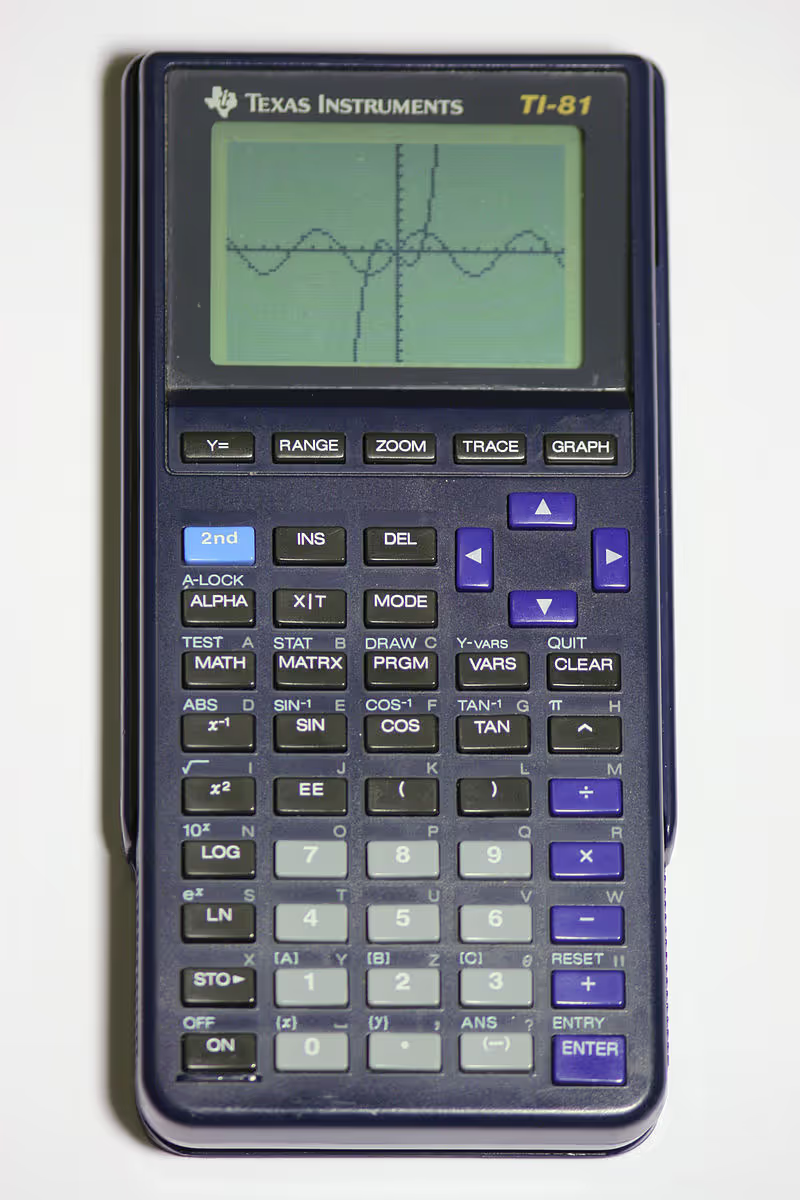
Four years later, Texas Instruments released the CBL™ Data Collection device, which helped students collect empirical data for math and science courses. The device helped foster solid primary research and analysis skills in a generation of young students.
Similarly, Texas Instruments introduced another research tool in the form of the first calculator with a built-in Computer Algebra System (CAS) which combined complex mathematics software in a small hand-held calculator.
By the time the 90s came to a close, Texas Instruments had also launched multiple upgraded versions of its TI-81 graphing calculator. The TI-83 Plus graphing calculator released in 1999 had Flash™ ROM technology which gave the new calculator six times the memory power compared to older versions.
The TI-83 Plus was very user-friendly and helped students perform data plotting as well as graph and compare functions.
Key Takeaway 3: Strategic Acquisitions Help Scale Up
Texas Instruments has evolved over the years to become a broad-based conglomerate with expertise in several areas such as defense electronics, microchip processing, and mobile computing, to name a few.
But the company soon decided that it wanted to focus solely on its latest invention, which was the digital signal processor. The DSP and other semiconductors could have multiple applications across industries, so demand for these products was expected to grow exponentially in the years to come.
Texas Instruments realized early on that further research and development were needed in the semiconductors and DSPs field to customize the products for specific applications and industries.
Hence, the company embarked on a strategic acquisition plan to acquire businesses that were more closely aligned with Texas Instruments's new DSP focus.
Texas Instruments Digital Transformation Strategy In 21st Century
Texas Instruments has been making digitalization possible ever since it developed the first digital signal processor.
The company restructured itself by shedding non-core business divisions to solely focus on its DSP and semiconductor sector because it knew well ahead of the competition that digitalization was the future.
A Semiconductor Powerhouse in the Making
Texas Instruments continued with its strategic acquisition plan in line with its renewed DSP focus. Over the course of ten years, the company continued to acquire businesses that would help it become a semiconductor powerhouse, specializing in analog and DSP products.
In 2000, Texas Instruments acquired Burr Brown Corporation in a stock-for-stock acquisition for $7.6 billion ($12.8 billion today after adjusting for inflation). The acquisition gave Texas Instruments access to expertise in developing better analog products such as data converters and amplifiers.
In 2006, Texas Instruments acquired Chipcon for $200 million (close to $0.3 billion today after adjusting for inflation). The move helped Texas Instruments expand its analog portfolio. The company could now offer its customers complete short-range wireless solutions for consumer, home, and building automation applications.
Texas Instruments also acquired Luminary Micro in 2009. Luminary Micro specialized in the development of microcontroller chips so the acquisition helped Texas Instruments expand its ARM®-based microcontroller catalog.
Finally, Texas Instruments acquired National Semiconductor for $5.6 billion ($7.2 billion today after adjusting for inflation) in 2011. National Semiconductor was an industry leader in the production of high-performance analog integrated circuits.
These circuits were also very user-friendly and could be incorporated into multiple electronic systems. They also had the advantage of being energy-efficient using far less power compared to other analog circuits.
In 2010, National Semiconductor reported sales of $1.42 billion ($1.8 billion today after adjusting for inflation). Hence, Texas Instruments knew that the acquisition of National Semiconductor was a sound investment for multiple reasons.
Firstly, National Semiconductor had a solid consumer base in the industrial power market. Secondly, the acquisition would help Texas Instruments add almost 12,000 analog products to its existing analog portfolio which already consisted of over 30,000 products.
The strategic acquisition of these businesses helped Texas Instruments tap into the design expertise, portfolios and consumer base of each of these companies. Combined with its own design expertise and products, Texas Instruments was able to provide customers with a portfolio of unmatched depth.
The company could now offer clients a product for almost any kind of industrial or consumer application. The complementary portfolios of its acquisitions helped Texas Instruments fuel growth for the next ten years until it became the undisputed leader in the semiconductors industry.
Analog Products Make Digitalization Possible
Texas Instruments's transition from a broad-based conglomerate to an analog and embedded processing company began in the early 90s when it decided to reinvent itself as a semiconductor powerhouse.
That journey culminated in 2012, with over 70% of Texas Instruments's revenue coming from analog and embedded processing which are the best semiconductor markets in the world.
Analog chips are found in almost every electronic device in the world. Together, millions of customers use analog and embedded processing technologies in extremely diverse applications from computing and automation to industrial and consumer industries.
Today, Texas Instruments has four main business divisions: analog products, embedded processing, digital light processing, and educational technologies.
Texas Instruments is the world's largest supplier of analog semiconductors, which convert real-world data such as temperature and sound into digital data.
Around 55% of Texas Instruments's portfolio consists of customized analog products that are tailored to the customer’s needs and specific applications. The remainder consists of high-performance standard products and commodity standard products.
Embedded Processors Help Digitize Systems
Furthermore, Texas Instruments offers a wide range of embedded processors, including microcontrollers (MCUs), digital signal processors (DSPs), and ARM®-based microprocessors (ARM MPUs).
It helps its customers build cost-effective embedded systems using its digital signal processors and ARM-based microprocessors.
Texas Instruments is a one-stop platform that provides technology and software such as embedded processors to customers that can be used on multiple projects by combining code in different ways. Hence, the company provides technological support and expertise to help its customers digitize their systems faster than ever before.
For instance, Texas Instruments produces custom DSP for customers so that they do not have to design their own hardware from scratch. It produces application-specific DSPs to be used in various industries, such as wireless infrastructure and digital cameras.
Around 80% of the company's DSP revenue comes from cell phone manufacturers. The cell phone industry requires a combination of analog products and DSPs to create specialized analog-to-digital converters.
The converters are the first step toward digitalizing any device or operating system, so Texas Instruments essentially provides the building blocks to industries that want to digitally transform their operations and products.
The company also continues to produce digital light processors (DLP), which use optical semiconductors to digitally manipulate light.
Hence, the DLP devices were initially used in projectors and H.D. televisions. However, Texas Instruments is constantly working to find new applications for its DLP products, which can also be used in 3D scanning and direct imaging products.
TI’s Innovation Strategy brings Hi-Tech Into the Classroom
Texas Instruments's commitment to producing high-quality educational technology continues to this day.
In recent years the company. In 2011, Texas Instruments released the TI-Nspire, which were full-color graphing calculators that were connected to a digital classroom system that helped teachers supervise student work in real-time.
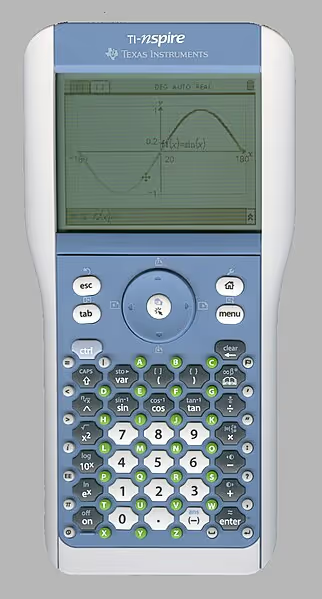
Two years later, it launched the TI-Nspire graphing calculator apps for Apple devices such as the iPad.
In 2016, Texas Instruments released the TI-Innovator™ Hub, which is a tiny pocket-size box with an in-built microprocessor. Students can easily connect their TI-84 Plus C.E. or TI-Nspire™ CX graphing calculators to the microprocessor to learn coding and engineering design.
Previously, this technology was only available to engineers, but Texas Instruments has brought it into the classroom to train a new generation of students who can come up with smart solutions such as low-cost 3D printing.
In 2017, Texas Instruments launched the TI-Innovator robotic rover to help students get a taste of advanced robotics.
The rover is actually an application of the TI-Innovator™ Hub, and the process is the same.
Students just have to plug in their graphing calculators into the microprocessor, which translates the code into the rover to control its movements.
TI’s Digital Transformation Strategy KickStarts Industrial Digitalization
In 2012, CEO Rich Templeton laid out a strategy to increase Texas Instruments.'s semiconductor penetration in the industrial sector.
He was confident that Texas Instruments's analog and embedded processing technology could help industries produce better digital devices, from smart home thermostats to self-regulating motors.
These smart devices would automatically adjust to new stimuli, but they would also learn to use less power in their operations over time through the power of A.I. and machine learning.
That vision has been translated into Texas Instruments.'s present Industrial 4.0 strategy that aims to kick start the digitalization of systems across industries such as robot and tool control, environmental control, EDGE Computing, machine vision, autonomous guided vehicle, and industrial communication.
The strategy involves:
- Creating innovative analog and embedded processing products for diverse industrial needs
- Creating user-friendly design tools such as fully tested system reference designs, software, and development tools
- Providing product and systems expertise to help customers use Texas Instruments. software across multiple projects and use analog products and microprocessors in brand new applications
Texas Instruments's portfolio contains products with long life cycles and multiple applications so that customers can use them in creative ways to create new cutting-edge products.
The latest products also use less power than earlier products because Texas Instruments is aware that products with low power consumption are sought after by customers across industries.
Texas Instruments also provides design support and online training so that customers can get their products up and running and ready to market in as little time as possible.
Key Takeaway 4: Reinvent Yourself To Meet Consumer Needs
Over the years, Texas Instruments has demonstrated that it can continuously reinvent itself to align with consumer demands.
First, the Texas Instruments leadership revamped the entire organization from an oil and gas exploration service into an electronics company because Texas Instruments knew that its products were highly sought after in diverse markets from defense electronics to consumer goods.
As Texas Instruments entered the 21st century, it realized that the time was ripe for another transition. Digitalization was going to be the future, so the company decided to shed its other businesses to focus on becoming an analog and embedded processing company.
Today, it provides highly advanced products that can be used to make digital products in the industrial and automotive sectors.
Texas Instruments Today & Key Strategic Takeaways
Today, Texas Instruments stands tall as an analog and embedded processing giant almost 100 years after it first started out as a small-time oil and gas exploration company.
Due to its lifelong commitment to innovation, the company has been able to flourish in a rapidly changing global environment.
Let's take a look at Texas Instruments's mission and values that fueled the company's growth and helped it become the undisputed leader of the American electronics industry.
Texas Instrument’s Mission
Texas Instruments makes analog and embedded chips to manufacture reliable products that can help customers solve real-world problems and thrive in an ever-evolving world.
It aspires to make technology smaller, more efficient, reliable, and affordable through effective engineering processes and continuous innovation.
Texas Instrument’s Values
Following are the five core values that shape everything Texas Instruments does:
- Trustworthy
- Inclusive
- Innovative
- Competitive
- Results-oriented
The company wants to create a work culture that values the ability to do the right thing and allows people to put ideas and thoughts on the table.
Texas Instruments aims to create innovative products that can deliver results for customers and penetrate new markets to stay ahead of the competition.
Texas Instruments’ Growth by Numbers
Strategies to Learn from Texas Instruments Journey
Texas Instruments’s journey has the following strategic takeaways to offer:
1. Innovate Like Your Life Depends On It
Nothing beats innovation and quality products. Without advanced and reliable products, no company can hope to retain customers.
Texas Instruments's history is littered with multiple inventions thanks to its robust culture of innovation.
The company is always studying its surroundings to develop new ways of solving real-world problems.
Texas Instruments calls it engineering progress, and this attitude has helped the company create products with long life cycles that can be incorporated into all kinds of electronic devices.
2. Attract & Retain Top Talent
Texas Instruments has worked hard to create a workplace environment that is open, non-hierarchical and encourages employees to think outside the box.
The strategy has helped Texas Instruments attract and retain the brightest researchers of the day, from Gordon Teal to Nobel Prize winning Jack Kilby, who invented the revolutionary integrated circuit.
The focus has always been on making sure different voices are heard to incorporate new ideas into the design process.
3. Always Focus On Your Core Business
Texas Instruments understands the value of strategic acquisitions and divestitures.
The company has always worked hard to acquire business that will help it focus on its core business with laser precision.
Strategic acquisitions have helped the company gain access to capital and expertise that will fuel innovation and help it refine its existing technology to create better products for its customers.
4. Customer Satisfaction is the Key to Success
Nothing trumps customer satisfaction. Texas Instruments's strategy has always been to create products that satisfy consumer needs. It has done this in two main ways.
Firstly, the company has always created products with multiple uses and can be incorporated into many devices and operating systems.
Secondly, the company creates products that use less power as sustainable products are the need of the hour for all customers and industries.
Texas Instruments has come a long way from being an oil exploration firm to becoming the world's largest supplier of semiconductors. Its intense focus on innovation has helped the company manufacture products such as integrated circuits and microcomputers. These products have revolutionized the production of all manner of goods, from digital watches and calculators to the latest autonomous guided vehicles. Furthermore, Texas Instruments's production of analog-to-digital converters, microprocessors, and DSPs helps the company lead the digital transformation of countless industries.


